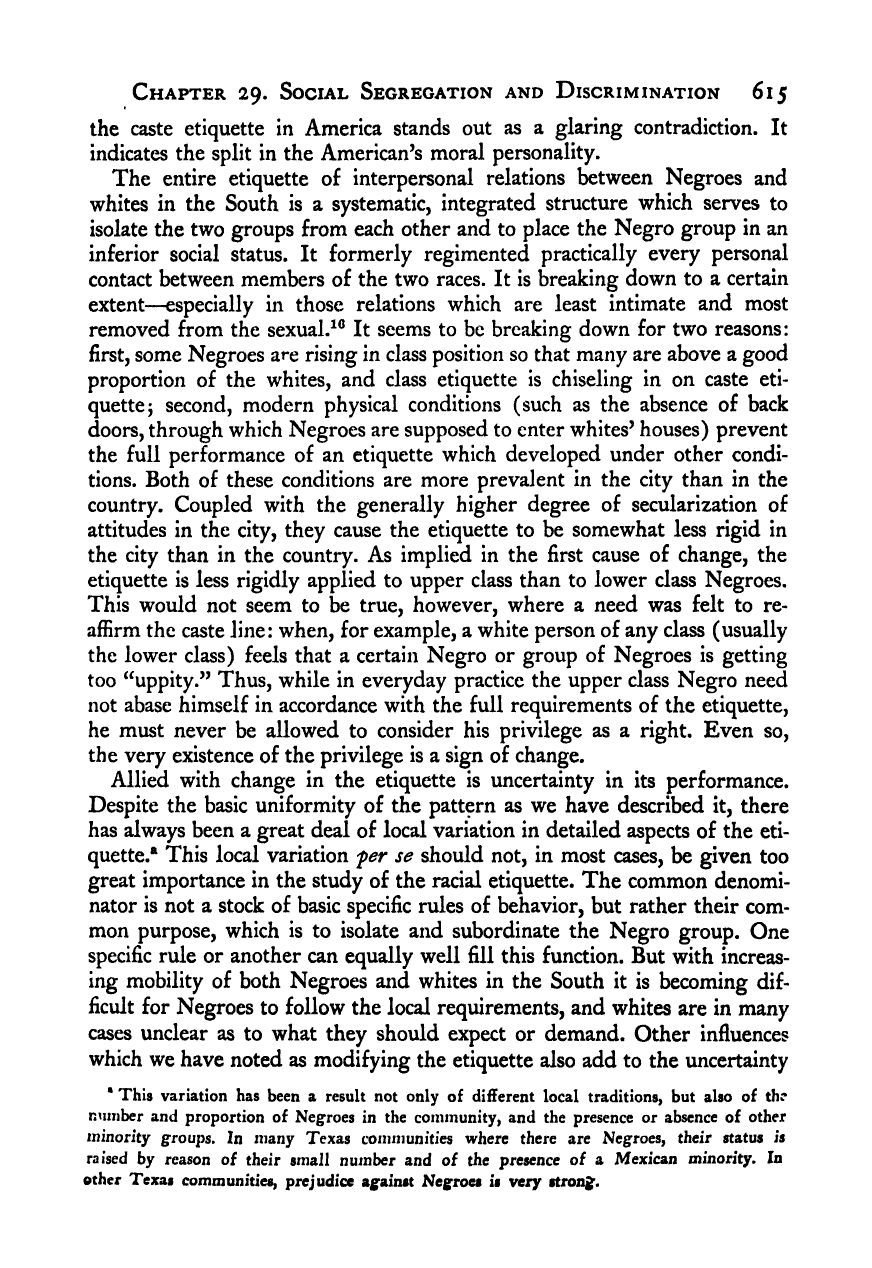Note: Gunnar Myrdal died in 1987, less than 70 years ago. Therefore, this work is protected by copyright, restricting your legal rights to reproduce it. However, you are welcome to view it on screen, as you do now. Read more about copyright.
Full resolution (TIFF) - On this page / på denna sida - VII. Social Inequality - 29. Patterns of Social Segregation and Discrimination - 2. Segregation and Discrimination in Interpersonal Relations

<< prev. page << föreg. sida << >> nästa sida >> next page >>
Below is the raw OCR text
from the above scanned image.
Do you see an error? Proofread the page now!
Här nedan syns maskintolkade texten från faksimilbilden ovan.
Ser du något fel? Korrekturläs sidan nu!
This page has never been proofread. / Denna sida har aldrig korrekturlästs.
Chapter 29. Social Segregation and Discrimination 615
the caste etiquette in America stands out as a glaring contradiction. It
indicates the split in the American’s moral personality.
The entire etiquette of interpersonal relations between Negroes and
whites in the South is a systematic, integrated structure which serves to
isolate the two groups from each other and to place the Negro group in an
inferior social status. It formerly regimented practically every personal
contact between members of the two races. It is breaking down to a certain
extent—especially in those relations which are least intimate and most
removed from the sexual.^® It seems to be breaking down for two reasons:
first, some Negroes are rising in class position so that many are above a good
proportion of the whites, and class etiquette is chiseling in on caste eti-
quette; second, modern physical conditions (such as the absence of back
doors, through which Negroes are supposed to enter whites’ houses) prevent
the full performance of an etiquette which developed under other condi-
tions. Both of these conditions are more prevalent in the city than in the
country. Coupled with the generally higher degree of secularization of
attitudes in the city, they cause the etiquette to be somewhat less rigid in
the city than in the country. As implied in the first cause of change, the
etiquette is less rigidly applied to upper class than to lower class Negroes.
This would not seem to be true, however, where a need was felt to re-
affirm the caste line: when, for example, a white person of any class (usually
the lower class) feels that a certain Negro or group of Negroes is getting
too ‘^uppity.” Thus, while in everyday practice the upper class Negro need
not abase himself in accordance with the full requirements of the etiquette,
he must never be allowed to consider his privilege as a right. Even so,
the very existence of the privilege is a sign of change.
Allied with change in the etiquette is uncertainty in its performance.
Despite the basic uniformity of the pattern as we have described it, there
has always been a great deal of local variation in detailed aspects of the eti-
quette.® This local variation fer se should not, in most cases, be given too
great importance in the study of the racial etiquette. The common denomi-
nator is not a stock of basic specific rules of behavior, but rather their com-
mon purpose, which is to isolate and subordinate the Negro group. One
specific rule or another can equally well fill this function. But with increas-
ing mobility of both Negroes and whites in the South it is becoming dif-
ficult for Negroes to follow the local requirements, and whites are in many
cases unclear as to what they should expect or demand. Other influences
which we have noted as modifying the etiquette also add to the uncertainty
* This variation has been a result not only of different local traditions, but also of the
number and proportion of Negroes in the community, and the presence or absence of other
minority groups. In many Texas communities where there are Negroes, their status is
raised by reason of their small number and of the presence of a Mexican minority. In
other Texas communities, prejudice against Negroes is very strong.
<< prev. page << föreg. sida << >> nästa sida >> next page >>